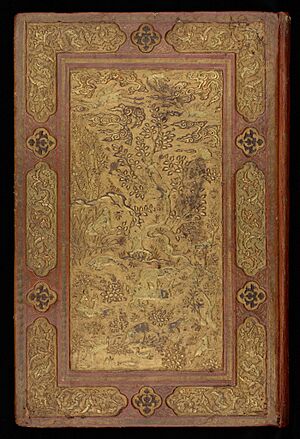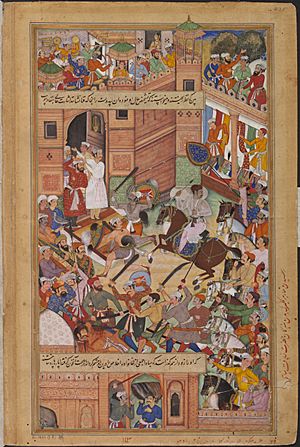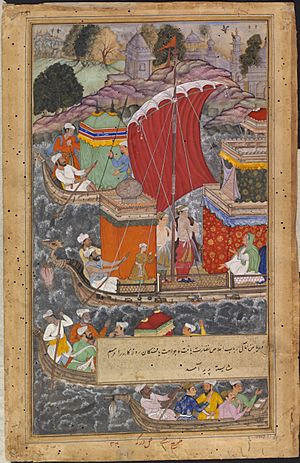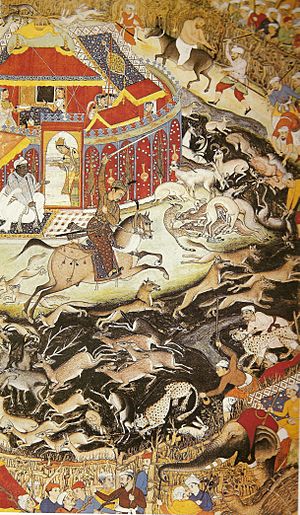Akbarnama facts for kids

Binding from "Akbarnama", c. 1600 – 1605 at the Chester Beatty Library.
|
|
| Author | Abul Fazl and Faizi Sirhindi |
|---|---|
| Country | Mughal Empire (India) |
| Language | Persian |
| Genre | Biography |
| Set in | 16–17th century Mughal India |
|
Publication date
|
1600–1605 |
The Akbarnama, which means "The Book of Akbar" in Persian, is a very important historical record. It tells the official story of Akbar, who was the third Mughal Emperor. He ruled from 1556 to 1605.
Akbar himself asked his court historian, Abul Fazl, to write this book. It was written in Persian, which was the main language used by the Mughals for writing. The book gives a clear and detailed look into Akbar's life and the times he lived in. It followed another famous book, the Baburnama, which was a personal diary by Akbar's grandfather, Babur. The Akbarnama was created as beautiful books with many amazing pictures.
Abul Fazl was one of Akbar's special advisors, known as the Nine Jewels. It took him seven years to finish the book. The original books had many small, detailed paintings called miniatures. These pictures helped tell the stories in the text. About forty-nine different artists from Akbar's royal art workshop worked on these paintings between 1592 and 1594. These artworks show the best of Mughal painting. Artists like Basawan were very skilled. He even started using real portraits in his art, which was new for Indian art.
After Akbar passed away in 1605, the Akbarnama books stayed in the royal libraries. They were kept by his son, Jahangir, and later by Shah Jahan. Today, a famous copy called the Victoria and Albert Akbarnama is at the Victoria and Albert Museum. It has 116 miniature paintings. The museum bought it in 1896. Later, the paintings were taken out of the book to be shown in frames.
Contents
What's Inside the Akbarnama?


The Akbarnama is divided into three main parts, or volumes. Each volume tells a different part of Akbar's story and the Mughal Empire.
Volume I: Akbar's Early Life
The first volume of the Akbarnama talks about Akbar's birth. It also covers the history of Timur's family, who were Akbar's ancestors. It tells about the reigns of Babur and Humayun, who were Akbar's grandfather and father. It also mentions the Suri rulers of Delhi before Akbar.
Abul Fazl describes how Akbar's father, Humayun, prayed for a son. After his prayer, Akbar's mother, Maryam Makani, showed signs of being pregnant. People believed a special light shone on her, blessing her and her unborn child. Nine months later, while Humayun was away, Maryam gave birth to Akbar. This happened under a lucky star, and everyone celebrated.
Volume II: Akbar's Reign and Battles
The second volume gives a detailed history of Akbar's rule up to the year 1602. It records many important events that happened during his time as emperor. For example, it describes how Bairam Khan and Akbar won the Second Battle of Panipat against Hemu. This was a very important battle for the Mughal Empire.
Volume III: The Ain-i-Akbari

The third volume is called the Ā’īn-i-Akbarī. This part describes how the Mughal Empire was run. It also includes a famous section about the knowledge and beliefs of Hindu people. This volume talks about Akbar's royal household and his army. It also details the empire's income and its geography.
The Ain-i-Akbari provides many interesting facts about the traditions and culture of people in India. It is known for its detailed numbers about things like how much food crops grew, prices, wages, and taxes. Abul Fazl wanted to describe the conditions of India and the beliefs of learned Hindus. He wrote about the main ideas of six major Hindu philosophies. He also included information about Jains, Buddhists, and Nāstikas. Much of this information came from old Sanskrit texts. Abul Fazl admitted he didn't know Sanskrit. He likely got this information from Jains, who were often at Akbar's court.
When describing Hinduism, Abul Fazl tried to explain it in a way Muslims could understand. Some strict Muslims thought Hindus were wrong for having many gods and worshipping idols. Abul Fazl explained that the symbols and images Hindus use are not idols. He said they are there to help people focus their minds on God. He wrote that only serving and worshipping God is truly important.
Abul Fazl also explained the Caste system to his readers. He wrote about the names, ranks, and duties of each main group. He then described the sixteen smaller groups that came from marriages between the main ones.
Next, Abul Fazl wrote about Karma. He called it an "amazing and extraordinary" system that all learned people in India agreed on. He explained how actions in this life could affect the next. He described different ways a person could be born into a different group or even change gender in the next life. He also talked about how actions could lead to diseases or problems like a woman being unable to have children. Finally, he discussed how actions related to money and generosity could affect one's future.
Today, a copy of the Ain-i-Akbari is kept in the Hazarduari Palace in West Bengal.
Other Versions of Akbarnama
There was another Akbarnama written by Shaikh Illahdad Faiz Sirhindi. This book was mostly a collection of information from other works. It used parts from the Tabaqat-i-Akbari and Abul Fazl's more famous Akbarnama. The only new parts in this book were a few poems and some interesting stories. Not much is known about Shaikh Illahdad Faiz Sirhindi himself. His father was a scholar, and the writer of the Tabaqat-i-Akbari was his student. Shaikh Faiz Sirhindi lived in Sirhind, a region in Delhi. He also worked for Shaikh Farid Bukhari, a high-ranking official. His most important work was a dictionary called Madar-ul-Afazil. He started his Akbarnama when he was 36 years old. His book also ends in 1602, just like Abul Fazl's. This version gives extra details about Shaikh Farid Bukhari's work. It also provides valuable information about the capture of Asirgarh fort.
Translations of Akbarnama
- Beveridge Henry. (translated) (1902–39, Reprinted 2010). The Akbarnama of Abu-L-Fazl in three volumes.
- The History of Akbar, Volume 1 (the Akbarnama), edited and translated by Wheeler M. Thackston, Murty Classical Library of India, Harvard University Press (January 2015), hardcover, 656 pages, ISBN: 9780674427754


